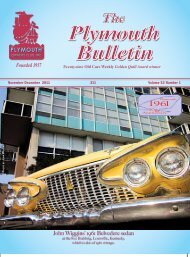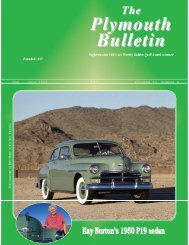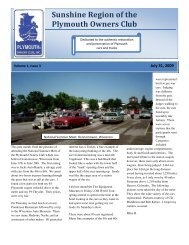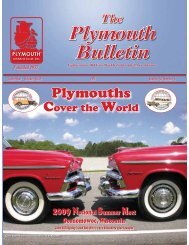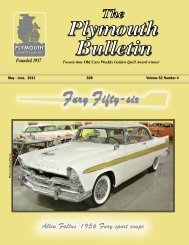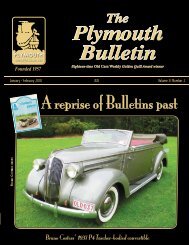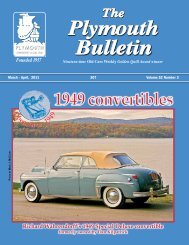Plymouth Owners Club - Plymouth Club
Plymouth Owners Club - Plymouth Club
Plymouth Owners Club - Plymouth Club
- No tags were found...
Create successful ePaper yourself
Turn your PDF publications into a flip-book with our unique Google optimized e-Paper software.
J. UPHOLSTERYDon’t confuse material and pattern. Material refers to rubber or fabric, etc. Pattern refers to rib design ortexture.1. Original FACTORY installed gets a bonus of 1 point, total score not to exceed 10. If one door panelhas been replaced but with material, design and workmanship equal to original then no penalty isrecommended.2. Material used on all rumble seats was leatherette.3. Door side panels of open body cars were leatherette.4. On closed cars prior to approximately 1939 the door panels were generally plain colored and notsame pattern or design as seats.5. Open body cars could have cloth or leather front seats.6. Some of the closed body cars could have leather seats (Owner must show acceptable proof - parts list,accessory catalog, etc.)7. Headlining always-light tan, flannel type material, in early years.8. Check for excessive wrinkles or bulges. Remember we are judging <strong>Plymouth</strong>s not custom bodiedclassics. Generally the leatherette covered wind lacing was wrinkled on turns.9. Seat belts standard starting in 1964. No deduction for seat belts.K. FLOOR COVERING1. Don’t confuse material and pattern. Material refers to rubber or fabric, etc. Pattern refers to ribdesign or texture. An owner with cloth carpet in front should lose at least two points - one forincorrect material and one for incorrect pattern. Generally the early fours and sixes will have auniversal rubber mat on the front which would be the correct material but incorrect pattern.2. Rubber pedal pads were not used on Q, U, and PT50 & PT57.3. All models used rubber in front and carpet in rear except some Business Coupes, which used rubbermat in rear.L. LIGHTING1. Wiring in this category is external only - not under hood or dash. Look for wiring to headlamps andtail lamps - does it have correct loom?a.) 1928-1929 headlamps had woven fabric loomb.) 1930-1932 headlamps had metal conduit loom2. Plastic insulated wire is wrong for pre-1949 models. All wire covering was cotton braid. A smalltracer indicated color. Some color was indicated by solid color also.3. One of the main purposes of this category is to check working condition of the lighting system (burnedout bulbs, defective switches, etc.).4. Tail lamp lenses on 1928 to 1931 models was the “bee hive” type. Some early 1932 to 1935 modelshad “PLYMOUTH” on lens. None of the commercial models had “PLYMOUTH” on lens. Someearly 1932 PB models used beehive also.5. If seal beams are present and correct for that year, patterns of lenses on both should match.6. 1937 PT50 truck headlamps & lens must be BI-RAY.7. 1937 P3, P4 headlamps say RITE-WAY.12



